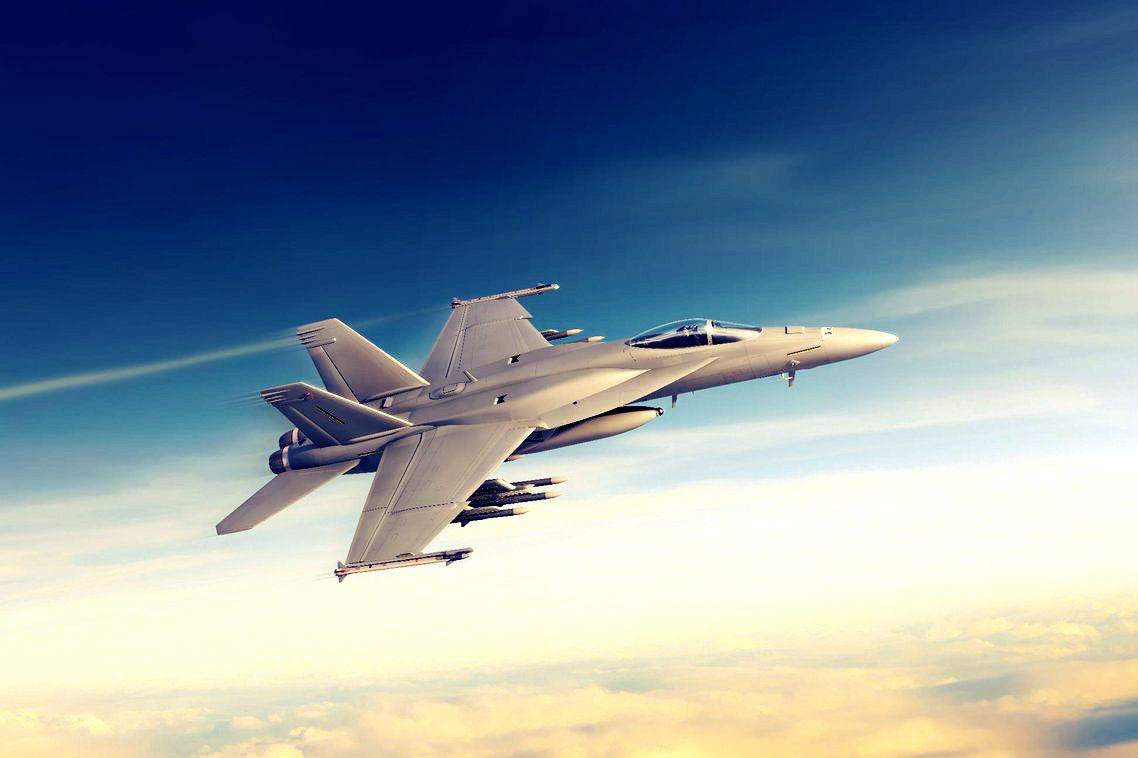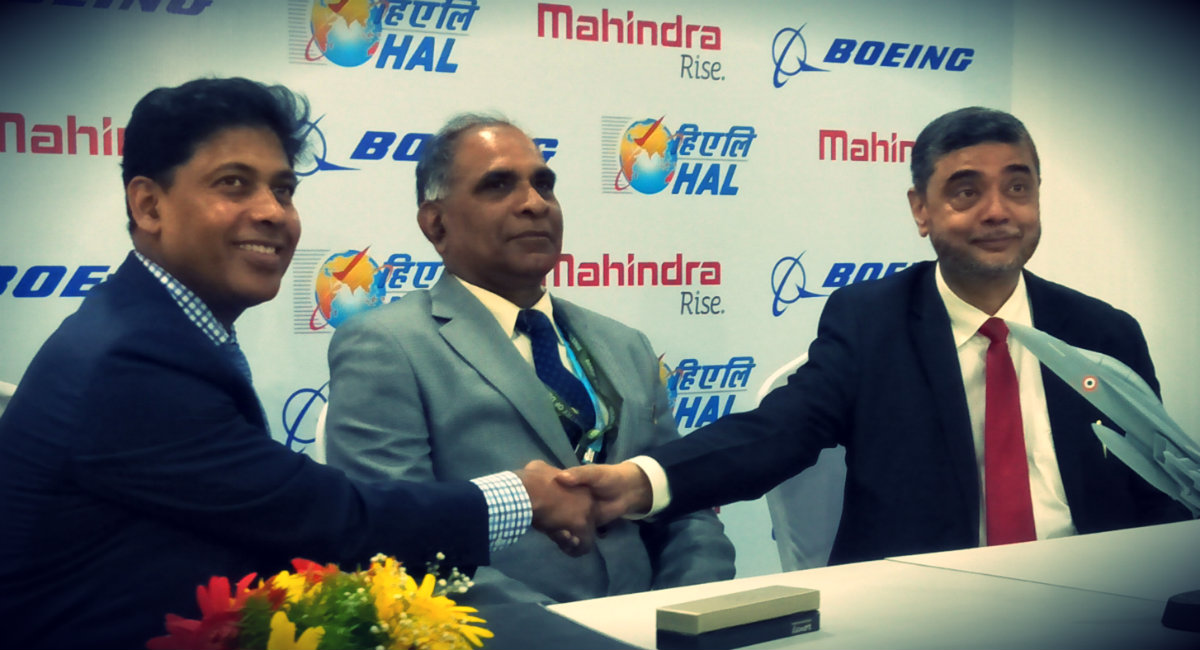
In the glacially meandering rivers of Indian military contracting, Boeing has had A wondrous run. Notching up one high value contract after another over the last decade, it has ably surfed the tide of a rapidly expanding strategic relationship between Delhi and Washington. From the Indian Air Force’s C-17 heavylifts to the Navy’s P-8Is, from Harpoon missiles for IAF Jaguars to the AH-64E Apaches and CH-57F Chinooks that will begin arriving under a year from now, Boeing’s record for landing deals has stood out in a field littered with the debris of collapsed or incomplete procurement efforts. An enormous amount of experience navigating the tough government bureaucracies of two big countries, from its decades of civil aircraft work, has certainly helped.
And now, Boeing has just made what is widely being seen as its sharpest move in a space it hasn’t managed to prevail in yet — India’s fighter aircraft arena. On Thursday, as reported first by Livefist, Boeing announced a three-way pact with India’s state-owned airframer Hindustan Aeronautics Ltd (HAL) and Mahindra Defence Systems (MDS) to build the F/A-18 Block III Super Hornet in India. It is indubitably premature to gauge how successful the new partnership will be in achieving what it sets out to, given that there remains little or no clarity on how the Indian government plans to evaluate the Super Hornet and its competitor aircraft for the proposed Make In India program envisaging a 110 jet purchase. But win or lose in the future, Boeing’s decision this week exudes shrewdness and establishes once again the enormous stakes at play for India’s ‘mother of all deals’. There are five reasons why.

[dropcap]1.[/dropcap] In one fell swoop, Boeing has taken India’s Strategic Partnership model, considered it from all sides, and turned it on its head. While it has drafted in the credible and proven Mahindra Group to satisfy the private sector element, it has co-opted the entity that still wields the most important industrial aerospace influence in the country — Hindustan Aeronautics Ltd. HAL, the sole intended recipient of major technology and production work under the erstwhile MMRCA program, had been specifically kept out of India’s new Strategic Partnership model, which looks to build similar capacity and capability in the private sector. As such, HAL hasn’t enjoyed being left out in the cold, given its decades of monopoly, but has had to play along for two reasons. (a) Its already overflowing order books, and (b) the government’s Make in India campaign heralds enormous promises about leveling the playing field for the ignored private sector, and HAL simply can’t publicly wage war against a flagship campaign of this kind.
[dropcap]2.[/dropcap] By bringing them into the mix, Boeing has also effectively disarmed HAL. With its wide public sector influence, HAL has always had the capacity to be troublesome in a program that otherwise would have seen it demoted to only a potential Tier-1 supplier. The move makes HAL feel wanted again, and there’s no undervaluing that. Internally, HAL has rued the idea of not being the principal integrator of India’s next fighter. But this new agreement settles that sulk. HAL now stands satisfied to be up on stage with the world’s biggest aircraft company and one of India’s fastest rising private aerospace firms. In effect, HAL represents very precious ‘national insurance’ in a journey that will be beset with political and other pitfalls. “Boeing is excited to team up with India’s only company that manufactures combat fighters, HAL, and India’s only company that manufactures utility and surveillance aircrafts, Mahindra,” said Boeing India president Prat Kumar at the announcement Wednesday. HAL chairman T. Suvarna Raju, whose will regard the Wednesday agreement as a coup for the company, said, “This partnership with Boeing and Mahindra Defence Systems will create an opportunity to develop capabilities of the aerospace industry and strengthen indigenous platforms in India thereby contributing to the Make-in- India activities.”
It bears reiterating that there is no way to determine what the efficacy of the partnership will be, considering how little is known about precisely what sort of matrix India plans to use in choosing a fighter in the proposed competition. What it is reasonably to say is that the agreement could preclude several potential future pitfalls in a path that has become internationally notorious for whim.
[dropcap]3.[/dropcap] Boeing and HAL aren’t strangers by any stretch, and the three-way agreement has been in the works for over a year. Boeing delivered its first F/A-18, with gun-bay doors built by HAL, to the U.S. Navy in 2010. Since then, while there have been bumps in the road, the relationship has endured. Wednesday’s pact is undoubtedly the hard-nosed alignment of a wide set of interests, but it also represents the peaking of a relationship. It must be noted that all of the formidable vendors that Boeing goes up against — Lockheed-Martin, Dassault, Saab, MiG and Airbus — have existing industrial and sourcing relationships with HAL. What Boeing has done though is take its own existing relationship to the very visible top level. Boeing’s new agreement, as a result, becomes the only ‘public-private’ proposal in the race. The other existing pacts for India’s fighter build include Dassault-Reliance, Saab-Adani and Lockheed-Martin-Tata. Russia’s MiG and Airbus/Eurofighter are yet to formally designate their private sector partners for the Indian fighter contest. The truth is there is every chance that such tie-ups may ultimately be redundant under Chapter 7 rules of the Defence Procurement Procedure, which mandates a separate selection of the Indian partner under the Strategic Partnership model. The companies will need to respond by July to the Indian Air Force’s request for information.
[dropcap]4.[/dropcap] The three-way agreement could enormously ease the execution of offsets, if things get to that point. Offsets have evolved greatly since the MMRCA program at which time they were considered a unanimous nightmare. HAL has had problems absorbing and sustaining technologies from abroad, but represents a partner with a keen sense of how to navigate a difficult and evolving element of India’s new procurement process that isn’t going anywhere.
[dropcap]5.[/dropcap] Finally, HAL is no industrial spring chicken. And it wouldn’t want anyone to think it has been done any favours. It still enjoys the widest and deepest sense of the Indian supply base and its experience dominating the Indian military aircraft market affords it more than a little rapport with enterprises across the country. As Boeing looks to strengthen its supply base, a formidable state-owned partner doesn’t hurt.

Essentially only one point instead of five. Boeing + HAL(9000?).
buy rafale not f/a 18…rafale M!!!
All good and nice political and strategical talk apart. The super hornet is a highly incapable fighter. It works best when the enemy has no airforce at all. Thanks but the IAF will make a blunder if it goes for it. All current and future American planes (in the pipeline) are paper tigers. We need fresh new blood that only competent engineers with a modern outlook can develop.
EF typhoon, rafale, even the mig 31 is better than their crap. I dont have time to give a technical analysis, but war will teach whats really worth. and you will see.
It is sharpest move by Boeing because they didn’t ignore HAL as Dassault did in past.This is good strategy by Mr Pratyush. If Boeing incorporate some of F-22 tech in India specific F-18 for IAF and navy it will be good for make in India program.This tie up will pave way for more Apaches,Chinooks,& V-22s platforms and joint development of AMCA.Mr Pratyush should also explore the ways for AMCA with ADA and Boeing R&D team.
Great post and congrats to Boeing had a wondrous run. Good luck for your feature to make india Air Force’s to proud.